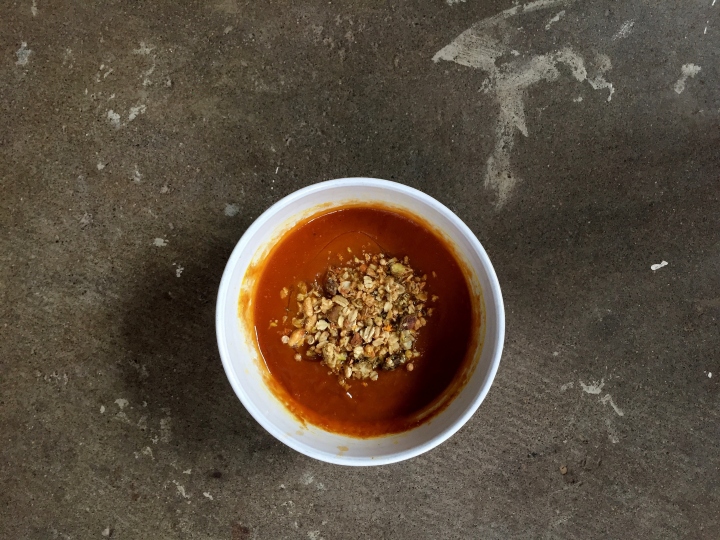
Just about every week I read a new article about the latest thing we should be eating, buying or doing for our health. Translated into actually eating food, one thing I’ve noticed is that for many people who tend to eat healthfully and particularly those that choose foods for athletes, there tends to be a lot of snacking throughout the day on products that aren’t terribly different than eating dessert…like granola.
Granola in and of itself is not necessarily an unhealthy food. In fact, we could do far worse than add it into our daily and weekly routines. If you’ve been around this blog long you’ll see I love granola and would choose it as dessert over many other options. But–depending on the type of granola you buy or make, there tends to be a lot of inflammation-promoting added sugar and refined oils. These are foods that aren’t doing us any good no matter how active we are, especially if they’re being eaten daily and make up as much as a quarter of our intake, as snacks or breakfast often do.
And if you have an autoimmune condition like celiac disease, hashimoto’s thyroiditis, ulcerative colitis or others, added sugar and refined oils can do extra damage.
Today I’ll focus on sugar specifically. (Read more here for my take on healthful oils.) As most of us know, sugar is a type of carbohydrate that our bodies need as energy, though there are substantial differences in quality depending on the type. Sugars are naturally present in many whole foods including fruits, vegetables, grains and dairy products. In whole foods, the sugars are balanced by the other nutrients. Refined sugars like plain old white or brown sugar, corn syrup, or organic cane sugar, have been processed so they are free of most nutrients and without their naturally containing minerals, they pass quickly into the bloodstream and create an imbalance in the body. They then weaken the digestive system and force the body to use minerals contained in our bones, blood, and other tissues to attempt to rebalance itself (1).

What about sugar cravings?
If you crave sweet foods, take a look at your entire diet and compare the quantity of sweet foods versus meat, salt, and dairy products that are being eaten. Sugar cravings might occur because the diet and body is out of balance by eating too many meat, salt, and dairy-containing foods. Thus, the body is subsequently craving expansive foods like sugar and ice cream to balance itself (2). Alternatively, you can also crave sugar because there is not enough protein compared to the amount of sugar consumed (1), or because you have a larger population of so-called “bad” gut microbes, and less of the good species, causing dysbiosis and cravings for the sugars that the bad microbes love to eat. Lastly, high stress or fatigue can lead to us grabbing for sugary feel-good foods for a quick dopamine rush, which is followed by a sugar crash a short while later.
Ultimately, no matter what your lifestyle or activity level, it’s usually more health-promoting to consume less sugars of all types and more whole foods that are naturally sweet. Look to use the types of sugar that are the least sweet and most whole-food based as possible. These include dates, honey, pure maple syrup, brown rice syrup, blackstrap molasses (actually a by-product of sugar refining but it contains lots of minerals), and fruit–like bananas or apples.
For some people with excessive sugar cravings, it’s best to cut it out completely and repopulate the gut with beneficial species for a while, but for most of us, a gradual reduction of sugar is more sustainable. This might mean switching both the type and quantity of sugar in baking and cooking over time, like starting with using 75% of what’s called for in a recipe.
Over time, you will desire sugar less and in smaller amounts. And things that you once thought were deliciously sweet are now just–sickly sweet.
Now, how about a granola recipe that tastes like banana bread and is heavy on the whole-food sugars? This is my current favorite when I’m really feeling like I need some delicious granola to snack on or have as an after-dinner treat.

Banana Hazelnut Granola
The addition of chickpea flour might seem a touch odd, but it makes this granola extra chunky. If you don’t care for clusters, go ahead and leave it out. Additionally, any flour will do but the choice of chickpea provides just a bit of extra protein to the mix. Likewise, using three cups of oats instead of half oats and half cereal is a great idea too.
1 1/2 cups old-fashioned oats
1 1/2 cups puffed or crispy rice cereal
1/2 cup toasted hazelnuts, roughly chopped
1/2 cup pumpkin seeds
1/4 tsp. salt
1/4 tsp. ground cardamom
3 Tbs. chickpea flour
2 medium bananas, mashed
3 Tbs. hazelnut butter
3 Tbs. pure maple syrup
1/2 tsp. vanilla extract
- Preheat the oven to 325 degrees F.
- Combine the oats, cereal, hazelnuts, seeds, salt, spices and chickpea flour in a large bowl, and then set aside.
- In a smaller bowl, mash the bananas and stir in the hazelnut butter, maple syrup and vanilla extract. Then pour the wet mix into the dry mix and stir until thoroughly combined.
- Spread the granola out onto a large baking sheet and pat down firmly so the granola will be extra chunky. Bake for 40-50 minutes rotating the sheet approximately halfway through. If it seems a touch soft at 50 minutes, turn off the oven and allow the pan to cool completely inside.
- Otherwise, remove from the oven and cool completely on the baking sheet before breaking into clumps and chucks.
References:
1: Pitchford, P. (2002). Healing with whole foods: Asian traditions and modern medicine. Berkeley, CA: North Atlantic Books.
2: Colbin, A. (1986). Food and healing. New York, NY: Ballantine Books.












